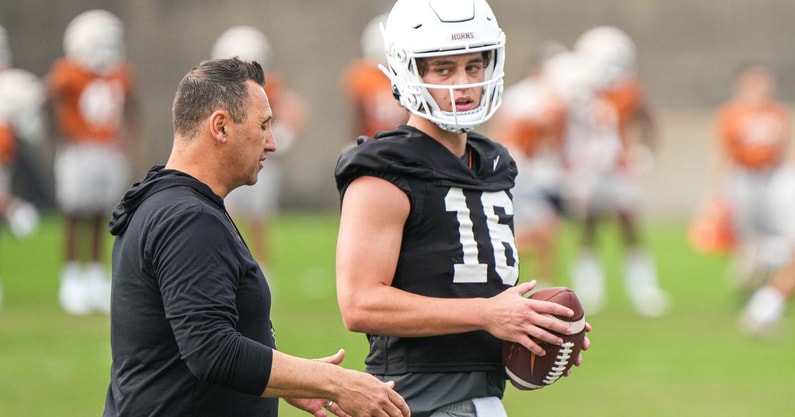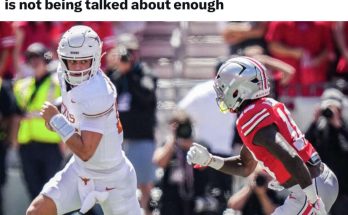Spring football is an exciting time for college football programs, as teams get a chance to work on fundamentals, develop younger players, and lay the groundwork for the upcoming season. For fans, it’s a chance to catch a glimpse of their team’s potential, discover new talent, and begin forming expectations for the fall. However, as much as spring football can provide insights into a program’s future, there are certain things that Texas football won’t teach us during this time. Spring football is an important phase in the development of a team, but it’s far from a fully representative snapshot of what the fall season will hold.
1. The True Starting Depth Chart
One of the most anticipated things for fans during spring football is the unveiling of a potential depth chart. The general assumption is that with a few weeks of practice, the coaching staff will have an idea of who will be the starters come the fall. However, the reality is that spring football doesn’t provide a clear, accurate picture of who will actually be starting when the regular season kicks off.
Several factors come into play here. First, spring football is largely about evaluating players, developing talent, and experimenting with lineups. Coaches aren’t necessarily locked into playing their best players; rather, they want to see how individuals perform in various situations. This means that some players who are on the first-team offense or defense during the spring may not necessarily be the starters in the fall.
Second, key players may be absent from spring practices due to injury, class schedules, or other commitments. While younger or less experienced players might get more reps during the spring, this does not necessarily mean they will start over established players when the season begins.
Finally, incoming transfers or freshmen who join the program in the summer could drastically change the depth chart by the time the season begins. Texas, like many big programs, often brings in talented recruits and transfers after the spring semester. These players might compete for starting roles, making it difficult to ascertain the true starting lineup during spring ball.
2. Full Offensive and Defensive Schemes
Another limitation of spring football is that teams do not typically reveal their full offensive and defensive schemes. Spring is more about installing basics and testing out different strategies than it is about showing everything a team has in its playbook. Coaches are keenly aware that the spring game is an exhibition and that opponents will study every piece of footage, so they don’t want to give too much away.
For Texas, a team that has historically had varying levels of offensive consistency, head coach Steve Sarkisian likely isn’t going to give away all his cards during the spring. While fans might get a taste of how the offense is evolving, we won’t see the complete depth of the offensive playbook or how Texas plans to attack specific opponents. Similarly, defensive coordinator Pete Kwiatkowski isn’t going to show every exotic blitz or coverage scheme, particularly with an eye on conference rivals like Oklahoma, Baylor, and Kansas State.
Instead, expect to see the basics: a few passing concepts, some running plays, base formations, and vanilla defensive fronts. Sarkisian will want to get the ball into the hands of his playmakers, but he won’t be unveiling every wrinkle of his strategy. In fact, even the play-calling during the spring game is usually more focused on developing players than executing complex, high-leverage situations. The bulk of the tactical strategy will unfold later in the summer and fall.
3. Game-Ready Performance and Execution Under Pressure
Spring football is a valuable tool for coaches to evaluate talent, but it’s not an environment that accurately simulates the pressure and intensity of a regular-season game. It’s easy for players to look good in practice or in a low-stakes spring game when the adrenaline of real competition isn’t on the line. The spring game is far removed from the high-stress, high-stakes situations that arise during an actual football season.
Texas fans, especially those who are eager to see the development of players like quarterback Arch Manning, may be looking for signs of game-ready performance in the spring. However, it’s important to remember that players may shine in spring but falter when the pressure is ramped up. Practice settings don’t replicate the tension of a packed stadium or the pressure of being in a close game in the fourth quarter. How players handle adversity, execute in crunch-time situations, and perform when the stakes are highest won’t be revealed until the fall.
Moreover, coaching staffs will deliberately avoid throwing their players into high-stakes situations during the spring. Coaches want to assess fundamentals and development without overwhelming the team with complex game scenarios. Spring football is about honing skills, not showcasing clutch performance. As a result, we won’t learn much about how players handle pressure during the spring.
4. The Full Health of the Roster
Health is one of the most important factors for any college football team, but spring practices don’t always give a clear picture of a team’s full potential in terms of health. Injuries happen, and many programs, including Texas, often deal with players sitting out spring ball to recover from surgeries, nagging injuries, or simply for preventative reasons.
Texas will likely be careful with key players, especially those who are dealing with lingering injuries or who have high expectations for the fall. This means that fans may not see the full breadth of the team’s talent during the spring. Star players may be limited or completely absent from practices. Injuries can cloud our understanding of who the best players are and how a given position group stacks up against the competition.
For example, if a starting linebacker is sidelined during the spring, the coaching staff will likely give younger players the chance to prove themselves, which could lead to a shift in perceived depth or skill levels. However, once the regular season starts, those sidelined players will be healthy and back in the mix, altering the dynamics of the team. Thus, spring football doesn’t always provide the clearest view of the team’s actual potential when it’s at full strength.
5. The True Chemistry of the Team
Football is a team sport, and one of the most vital elements to any successful squad is chemistry. Coaches often look for leadership, communication, and a cohesive unit both on and off the field. While spring football is an opportunity to work on fundamentals and evaluate individual talent, it doesn’t always showcase how well a team is coming together as a whole.
Spring football can give us a glimpse of individual players and how they are developing, but it doesn’t show us how those players will gel when it’s time to face a team under the spotlight. Relationships between players, particularly between a quarterback and his offensive line or between linebackers and defensive backs, take time to develop. Spring practices allow teams to begin building that chemistry, but it’s only in the pressure cooker of the season—when injuries start to pile up, when mistakes are made, and when adversity strikes—that the true chemistry of a team is tested.
For Texas, this is particularly important as the Longhorns prepare to rely on young, emerging players. How those players respond to each other in real-game situations will shape the identity of the team. But fans won’t get the full picture of this during spring.
6. How the Team Will Respond to Real Adversity
One of the key things that spring football won’t teach us is how the team will respond to true adversity during the season. The Longhorns will undoubtedly face challenges during the year—tough road games, difficult opponents, and inevitable injuries. How the team responds to these challenges is one of the most important factors in determining success, but spring football can’t fully replicate this.
During spring ball, Texas will face relatively little adversity. The pressure is off, and there are no meaningful wins or losses on the line. Once the season begins, the stakes are much higher. How players handle mistakes, how coaches adjust to in-game situations, and how the team maintains focus during difficult stretches won’t be known until those moments arise in the regular season.



